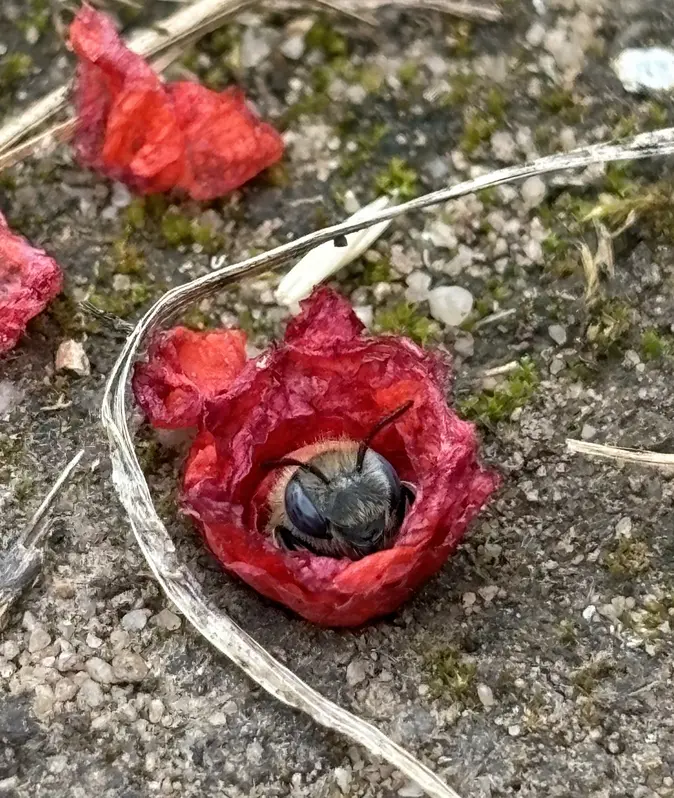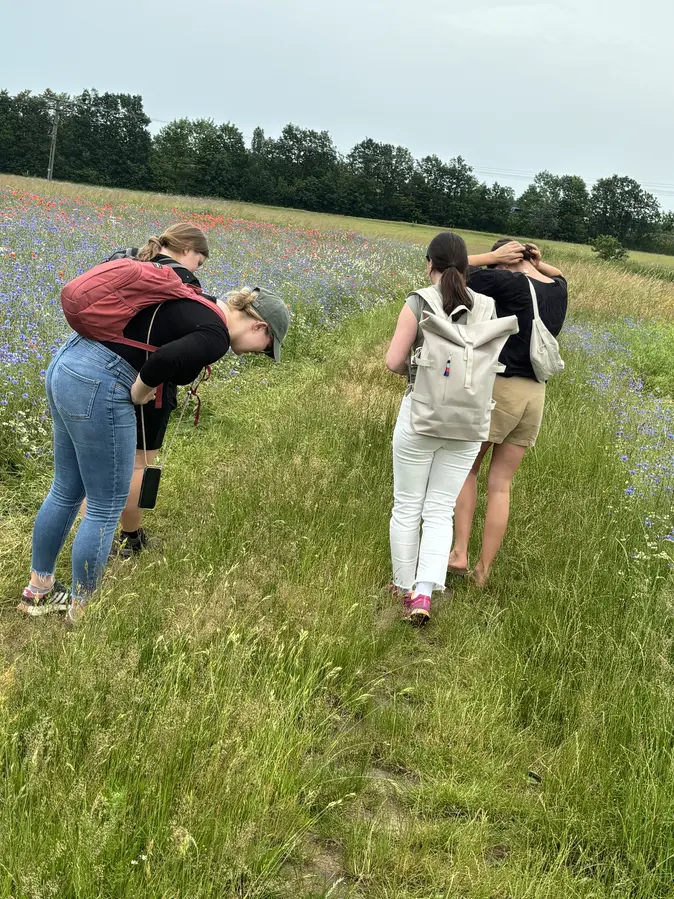[Translate to English:] Eine weibliche Mohnbiene beim Nestbau. Die Auskleidung ihrer Niströhre ist abgeschlossen und sie ist nun dabei, den Pollenvorrat für ihre Larve anzulegen. (Foto: Maurice Kalweit)
[Translate to English:] Studierende suchen die Feldwege nach Mohnbienennestern im Boden ab. (Foto: Maurice Kalweit)
The fascination of the poppy bee (Osmia papaveris) - students at the University of Bamberg map rare wild bee
The fascination of the poppy bee - students at the University of Bamberg map rare wild bee
In Kemmern in the district of Bamberg, an impressive bee species is causing great excitement. One of the largest known populations of the rare poppy bee (Osmia papaveris) can be found in the fields north of Kemmern. Students from the University of Bamberg examined the poppy bee population in a large-scale mapping campaign on June 20 and discovered something impressive: the number of poppy bees seems to be increasing!
The poppy bee is known for its characteristic behavior of lining its nest with poppy petals and is considered endangered in Germany. It nests in the ground and prefers compacted, sandy and warm locations. It digs 3-4 cm deep holes in the ground for its nesting tubes. It does not seem to like clutter, as it meticulously carries the excavated sand grains about a meter away. She then lines her nesting tube with many small pieces of poppy blossom. The poppy petals protrude from the top of the nesting tube like a red sack. As soon as she has finished lining her nesting tube, she diligently collects pollen and carries it into the tube as food for her offspring. The poppy bee lays another egg on the pollen and carefully closes its nesting tube by folding up the pieces of poppy flower over the brood cell and scattering grains of sand over them again. The larva is now well packed with its food supply in a ball wrapped in poppy petals and can develop safely underground. The new poppy bee does not hatch until a year later in June and remains well hidden in the soil until then.
Kemmern near Bamberg is home to one of the largest populations of this rare and fascinating species of wild bee. The reason for this is the extraordinary landscape, which is characterized by historically evolved, small-scale agriculture. Fields, flower strips and hedgerows alternate in a very small area and are connected by field paths. The field paths are the preferred nesting place for poppy bees and, fortunately for them, there are also plenty of poppies in the area. This historical landscape structure promotes the enormous diversity of species in Kemmern, which must be preserved at all costs. The greatest threat to the poppy bee is said to be construction work and land consolidation, both of which would make the habitat unusable for this wild bee species.
A mapping carried out last year by the Landesbund für Vogel- und Naturschutz (LBV) Bamberg showed a positive development in the poppy bee population over the last 20 years. Now, students from the University of Bamberg, Didactics of Natural Sciences, led by Dr. Larsen, Mr. Kalweit and Ms. Hochrein, have carried out a mapping and counted an incredible 352 nests. This exceeds last year's daily maximum by a factor of three. The results indicate that the poppy bee population is continuing to grow. The not only permanent, but even increasing occurrence of the poppy bee in Kemmern clearly shows how exceptional and valuable the landscape there is. Participant Anna Weiser came to the conclusion that "a landscape that has actually been strongly shaped by humans, namely the agricultural cultivation of fields, can also bring with it a high level of species richness. The prerequisite for this is natural, near-natural cultivation".
In addition to the poppy bee, many other interesting and quite rare species live in the small-structured fields of Kemmern. During the mapping, for example, the rare spider wasp and the grasshopper sand wasp were observed building their nests. Through the intensive study of the poppy bee and its winged neighbors, the participants became aware "that the beauty of nature can be seen in its smallness and diversity, which must be protected at all costs". Maurice Kalweit concluded by saying that "even if appearances may be deceptive, fascinating life can be found almost everywhere, making hearts beat faster for our natural world again".
Sophia Hochrein


